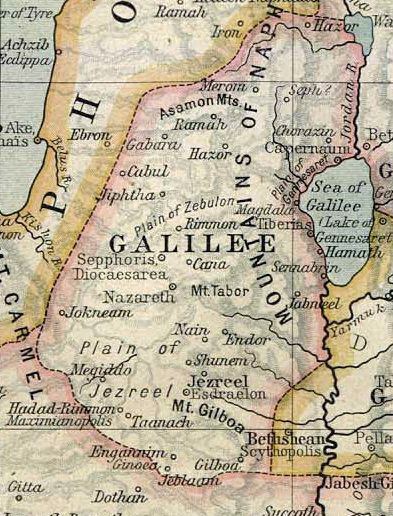 | ||
Matthew 4:13 is the thirteenth verse of the fourth chapter of the Gospel of Matthew in the New Testament. In the previous verse Jesus returned to Galilee after hearing of the arrest of John the Baptist. In this verse he leaves from Nazareth to Capernaum.
In the King James Version of the Bible the text reads:
And leaving Nazareth, he came and dweltin Capernaum, which is upon the sea coast,in the borders of Zabulon and Nephthalim:The World English Bible translates the passage as:
Leaving Nazareth, he came and lived inCapernaum, which is by the sea, inthe region of Zebulun and Naphtali,For a collection of other versions see BibRef Matthew 4:13
It is presumed that Jesus returned to Nazareth since Matthew 2:23 described it as the town where he was raised. Matthew does not specify why Jesus leaves Nazareth, but it might be because of his rejection by the residents of that town as described in Luke 4. The original Greek of this verse has Nazareth spelt as "Nazara." The only other place this spelling occurs in the New Testament is in Luke 4:16. Hill notes that this has led scholars to believe that both Matthew and Luke were copying from another document, likely the hypothetical Q. Hill adds that this has also led some to believe that the entirety of the rejection scene was in Q but that the author of Matthew decided to leave it out.
At the time of Jesus, Capernaum was a sizeable town on the northwest shore of the Sea of Galilee, with a population of perhaps ten thousand. The description of the town's location comes straight from the quote from Isaiah that will be quoted in Matthew 4:15. Capernaum was located in Naphtali, but it was near Zebulun. The town is mentioned nowhere in the Old Testament, but does feature in all four Gospels. Matthew is the only source that has Jesus actually living in the town. The other three have him only preaching and meeting his disciples there. This also seems to conflict with the other gospels and the rest of Matthew, especially Matthew 8:20, which portray Jesus as an itinerant preacher with no permanent home. France feels that the town was less a home and more a base of operations to which Jesus and the disciples would occasionally return. Gundry rejects this view. To him dwelt unambiguously means that Jesus set up house in the town. Gundry feels that the author of Matthew embellished the accounts of Jesus' visits to Capernaum to better fit the quote from Isaiah. Matthew 11:23 has Jesus speaking out against the town.
Matthew does not mention why Jesus chose Capernaum to relocate to. The town was prosperous due to its location on the large lake and also its position on the Via Maris, the Damascus to Egypt trade route. France feels it was probably because the sizeable community offered more opportunities to preach. Albright and Mann support the theory that Jesus was already good friends with the disciples prior to recruiting them, and that Jesus specifically chose to move to Capernaum to be close to them.
Matthew here, and throughout the Gospel, refers to the local body of water as a sea. As it contains fresh water, by modern definitions it is more properly a lake. Luke refers to it as a lake, as does Josephus, but Mark and John join Matthew in calling it a sea. As a result "Sea of Galilee" is still the standard modern name.
